An LP or long play record can be costly and time-consuming, especially for independent artists, which is why many artists today begin their careers by recording EPs. If you are wondering what an EP is and what it can mean for an artist’s career, read on.
What Does it Mean?
An EP is a medium length album with fewer songs than an LP or a full-length album. They usually consist of four to six songs and around 40 minutes of playing time. This definition differed from the original one back in the 20th century when an EP was an extended play record. This was a vinyl that played at a different speed to standard play records. These meanings have changed over time as vinyls became obsolete. Nowadays, an LP is akin to a full album with at least eight tracks, unlike the EP.
Constructing an EP
Whilst you may have the material, it can be tough to know how to structure an EP release. Obviously, recording is the first step. EPs are cheaper to make than LPs as they require less studio time, making them ideal for emerging talents. Pirate have studios and rehearsal spaces in locations across the world. They also offer day-rate discounts meaning that if you’re prepared, you can get the material for your EP quickly and cheaply, bringing down production costs.
Many online music platforms only consider something an EP if it has between four and six tracks; whether you skew more towards the four or the six is entirely dependent on the musical genre, style and the purpose of the EP. If you wish to send the EP to labels, having the higher number would be beneficial to show more variety. If the aim is for promotion, then the smaller number can work better as a tantalising taste to bring in more listeners.
The length of the songs is also subjective, but on average, the aim should be for two and a half to three and a half minutes long. Some genres tend to lean towards lengthier songs, as is the style, but as an EP usually serves as a taster, it is better to be concise. Think of your EP as a showcase for your style, themes, and talent.
The Content
EPs do not allow much time for you as an artist to make an impression. There is no guarantee that the audience will like the songs you include. One way to try and sneakily get past this is to include a remix of one of your popular songs – if you have any other works out there. Or to remix another popular song and cover it. Remixing does not work for all styles of songs, which you need to keep in mind if you want to head down this route.
Consider adding an interlude. These are small filler tracks that can be purely instrumental or a conversation between band members. They help the album flow and can offer fans an insight into your personality and dynamics if you are a band. Interludes aren’t essential, but they can help your audiences’ perception of your music and yourself.
Promoting Your EP
It is vital that you have a release plan in mind. Your EP needs to reach as broad an audience as possible, so releasing it via many online channels is crucial. A solid social media presence can help promote your EP, countdown to the release date and celebrate its release – it’s an achievement after all. Some artists choose to throw release parties, whether in person or virtually, to celebrate the achievement further.
Consistency is key when building a fanbase. The internet has allowed unrepresented artists to gain traction in an industry where that was not possible previously. Use social media to your advantage to push your EP, post live versions of your songs and interact with fans.
The Cover
Artwork is an essential aspect of any release. The cover to your EP can make or break someone’s decision to listen to it. The cover should speak to your brand. This brand should be already carefully cultivated over your social media channels, and you can use that for inspiration. A good designer is critical and is a worthy investment in your EP.
On the cover or in the album description, you can include any calls to action for your audience. This can include your social media handles for people who discover you through your EP or a mailing list. These calls to action can promote brand awareness and help you gauge the reception of your EP; for example, you may find yourself gaining loads of new followers after the release, and this can be indicative of the reach that it has had.
In Conclusion
An EP is the most accessible album adjacent product that an emerging artist can make. If approached correctly, an EP can provide valuable exposure and benefits or maybe even a record deal. Once your music is out there, start sending it out to the relevant people – create your own opportunities.




